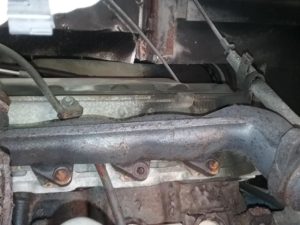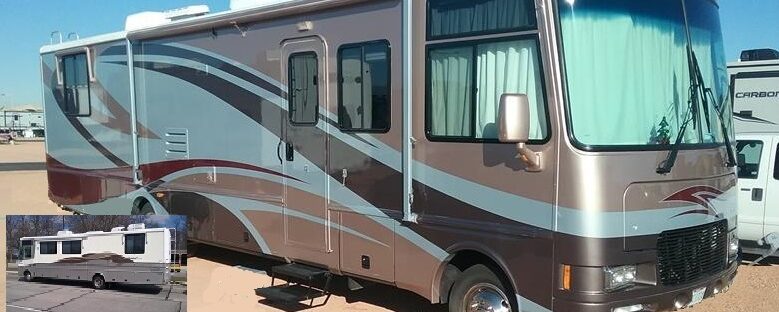I get asked these questions a lot: What causes this? Can I drive like this? When should I fix it?
To answer these questions, we need to know what happens as this failure progresses. The studs are exposed to heat cycling, road chemicals, and oxidation (rust) and the manifolds expand and contract. As the studs rust they get weaker, at some point when the manifold expands and vibrates, the stud breaks. Sometimes the nut is rusted to the manifold and looks OK, even though the stud is completely rusted away. The manifold pulls away from the head a little and exhaust gasses leak past the gasket and the proverbial ticking sounds (leaking exhaust) start. Initially, the ticking seems to go away as the engine warms up, but as more studs break and the gaskets burn away, it gets to the point where the ticking doesn’t go away. The broken studs place additional stress on the manifold, this could cause the manifold to crack/break, now the ticking sound is real loud..
You can see a broken stud (nut rusted off) on cylinder #9 in this photo. The nut on top of cylinder 9 is also missing. ALSO, what you can’t see, the stud is also broken on the top of cylinder 10, but the nut is still there, its rusted to the manifold. Notice the blackened area above the manifold cylinder 9 and 10, this is caused by the exhaust leak past the gasket.
 At what point do you say “Fix it”? This depends on how many studs are broke, who’s going to do the work, how much it costs, how far away from home you travel, how you plan on fixing it (just replace broken studs, or go for a complete headers, etc.
At what point do you say “Fix it”? This depends on how many studs are broke, who’s going to do the work, how much it costs, how far away from home you travel, how you plan on fixing it (just replace broken studs, or go for a complete headers, etc.
All of the studs rust and given enough time, they all will break. But its usually the rear cylinders that break first. The rear cylinders of the manifold are exposed to the most heat, plus the stress, vibration, and weight of the exhaust system that is attached to the manifold.
Most stud replacement is a pain in the butt, but can be done in the vehicle. Motor homes are nicer to work on than a pickup or van, as we have a lot more room to work.
WHAT TO DO:
At minimum, I’d consider replacing ALL the studs, not just the broken ones. This means the manifolds need to be removed. They’ll probably need to come off anyway to get to the broken stud. I’d also anticipate that you have more broken studs than what you can see. I could see two broken ones on mine, but I had 5 more that were broke but the nuts were rusted to the manifold. We also broke 5 more when removing the manifold, so I had 12 total.
If the OEM studs lasted 15-20 years, odds are your replacement studs will last 15-20 years.
My broken studs turned into a big job. Everyone who looked at it said this was the worst they have ever seen. I ended up removing the heads and a Machine shop worked them.
I wrote up a detailed article on my broken stud experience with a lot of photos: You can READ HERE

I own 1999 Dutch star. Replaced both sides using local truck shop.
Cost 365 $ and didn’t have to get frustrated. Most unscrewed some drilled out. Engine now super quiet. Do all at once. Milage was 73000 or so. Also replaced O2 sensors. That was easy. 321 999 4555
I think your situation is the normal. They come out, but just have to work at it and use a couple different techniques. Usually, if you can get a vice grip on the broken stud, wiggle it back and forth, the stud unscrews. The ones that are broke below the head, weld a nut to the broken stud twist back and forth, and it comes out.
My case was very, very unusual. Even the shop that ultimately repaired the heads said this was the worst that he has ever seen and had no idea why all of mine were so difficult to get out. about 1/2 of mine had to be completely drilled then the hole re-welded closed with aluminum, then a new hole drilled and tapped